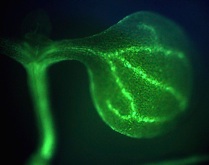RESOURCES :
Plant reproduction depends on a random rendez-vous, the first contact being when hundreds of pollen grains, carrying the male gametes, land on the surface of the female reproductive organ (stigma). The stigma has an active role in promoting compatible pollen acceptance, while discouraging the growth of undesirable pollen. Despite the widespread biological implications of stigmatic receptivity, very few stigmatic factors have been identified as active participants in early pollen recognition.
Our project aims at characterizing :
- the early cellular events
&
- the molecular responses of stigma epidermal cells following interaction with the pollen grain
Self-incompatibility (SI) is a cell/cell recognition system that prevents inbreeding in flowering plants by allowing the female organ, the pistil, to discriminate between self- and non self-pollen grains. In the Brassicaceae family, SI response is controlled by a receptor-ligand interaction, which involves the SRK receptor (S-locus Receptor Kinase) expressed in the epidermal cells of the pistil (stigmatic papillae) and its ligand SCR (S-locus Cysteine-Rich) carried by the pollen grain (Gaude et al., 2006).
Although the plant receptor-like kinase (RLK) family consists of more than 400 putative transmembrane proteins in Arabidopsis thaliana, less than half a dozen have clearly identified ligands with known physiological functions. Interestingly, SI signaling presents some unique features compared with the other known plant signaling pathways. Indeed, we unexpectedly found that SRK accumulates in intracellular compartments, with only a small portion being detected in patches at the plasma membrane (Ivanov and Gaude, 2009). Although not very abundant at the cell surface, we nevertheless demonstrated that SRK activation upon ligand binding takes place at the plasma membrane and is followed by internalization of the SRK-ligand complex and its transport to sorting endosomes (Ivanov and Gaude, 2009).
We now want to address :
-
-What is the role of vesicular trafficking in SI response?
-
-How papilla cells discriminate between self- and non-self pollen grains at the same time?
ISABELLE FOBIS-LOISY - Thierry gaude
CHRISTINE MIEGE (LECTURER)
VINCENT BAYLE (Engineer)
FREDerique rozier (ENGINEER)


SELECTED publications
Fobis-Loisy I, Jaillais Y "Feeling the pressure : A mechanical tale of the pollen tube journey through the pistil". Developmetal Cell 56 873-875 (2021) PMID : 33823132
Riglet L, Rozier F, Fobis-Loisy I, Gaude T. "KATANIN and cortical microtubule organization have a pivotal role in early pollen tube guidance". Plant Signal Behav. 16 (2021) PMID : 33960266
Kodera C#, Just J, Da Rocha M, Larrieu A, Riglet L, Legrand J, Rozier F, Gaude T, Fobis-Loisy I#. The molecular signatures of compatible and incompatible pollination. BMC genomics 22 268 (2021)
on bioRvix doi: https://doi.org/10.1101/374843
Riglet L, Rozier F, Kodera C, Fobis-Loisy I#, Gaude T#. KATANIN-dependent mechanical properties of the stigmatic cell wall mediate the pollen tube path in Arabidopsis. eLife. Sep1;9e57282. PMID: 32867920
Rozier F, Riglet L, Kodera C, Bayle V, Durand E, Schnabel J, Gaude T, Fobis-Loisy I#. "Live-cell imaging of early events following pollen perception in self-incompatible Arabidopsis thaliana.". J Exp Bot. 71 2513-2526 (2020) PMID : 31943064
Durand E, Méheust R, Soucaze M, Goubet PM, Gallina S, Poux C, Fobis-Loisy I, Guillon E, Gaude T, Sarazin A, Figeac M, Prat E, Marande W, Bergès H, Vekemans X, Billiard S, Castric V. 2014.Dominance hierarchy arising from the evolution of a complex small RNA regulatory network.
Science. Dec 5;346(6214):1200-5.
Goubet P, Berges H, Bellec A, Gallina S, Fobis-Loisy I, Vekemans X, Castric V.Contrasted pattern of molecular evolution in dominant and recessive self-incompatibility haplotypes in Arabidopsis. PLoS Genetics. 2012, 8(3):e1002495. doi: 10.1371/journal.pgen.1002495.
Ivanov R, Fobis-Loisy I, Gaude T. When no means no: guide to Brassicaceae self-incompatibility. Trends Plant Sci. 2010, 15:387-94.
Ivanov R, Gaude T. Endocytosis and endosomal regulation of the S-receptor kinase during the self-incompatibility response in Brassica oleracea. Plant Cell. 2009 21:2107-17.
Vanoosthuyse V, Tichtinsky G, Dumas C, Gaude T, Cock JM. Interaction of calmodulin, a sorting nexin and kinase-associated protein phosphatase with the Brassica oleracea S locus receptor kinase. Plant Physiology. 2003 133:919-29.
Cabrillac D, Cock JM, Dumas C, Gaude T. The S-locus receptor kinase is inhibited by thioredoxins and activated by pollen coat proteins. Nature. 2001 8;410:220-3.
Giranton JL, Dumas C, Cock JM, Gaude T. The integral membrane S-locus receptor kinase of Brassica has serine/threonine kinase activity in a membranous environment and spontaneously forms oligomers in planta. PNAS. 2000 28;97:3759-64.
Cell Signaling lab
RDP - ENS Lyon - 46 Allee d’italie
69364 Lyon cedex 07 - France


Web Site : Yvon Jaillais
- Plant Biology - Cell Biology - Plant development - Cell Signaling - Signal transduction - Receptor Kinase - Plant adaptation - Endocytosis - Self Incompatibility - Plant Reproduction - Brassinosteroid - Plant hormones - hormone crosstalk - Intracellular trafficking - Live confocal imaging - BRI1- BKI1- SRK - SCR - Retromer - SNX - Sorting Nexin - Vacuolar Protein Sorting - VPS - RDP, ENS Lyon, Ecole Normale Superieure - Laboratoire de Reproduction et development des plantes - France -


last update Sep 2020



OUR RESEARCH IS FUNDED BY:
ANR “BRA-SSI-DOM” in collaboration with Vincent Castric, University of Lille, France
ANR “INVADER” 2015-2018
in collaboration with Mathieu Gourgues, University of Nice France
Self/non-self recognition in plant reproduction
We have a subject available for a Master internship for 2020/2021: LOISY-RDP-2020-stage M2.pdf











































